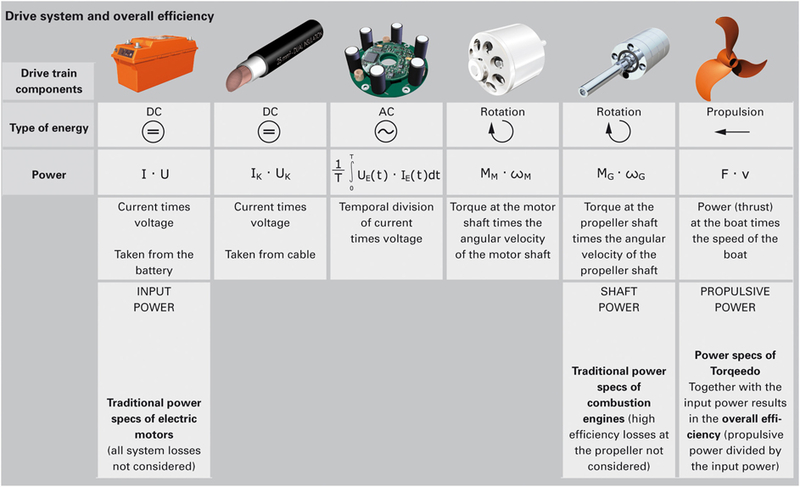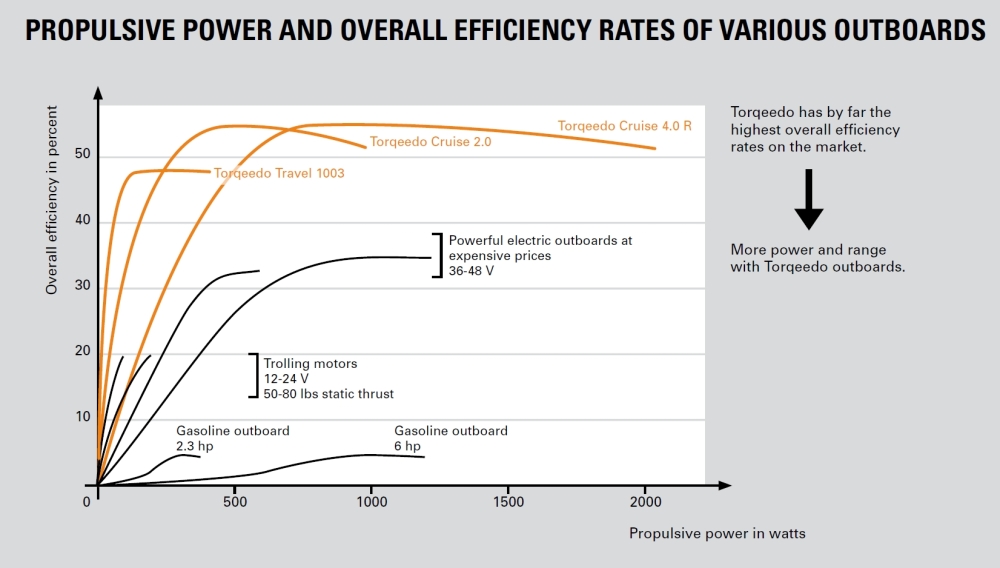 |
Technology Torqeedo Overall
efficiency
How
to compare the differents motors performance ?
|
www.torqeedo-belux.com



Torqeedo
provides meaningful performance indicators for boat drives.
Basically, the power of a drive is measured according to how
much propulsion it actually delivers for moving the boat. This
power is referred to as the output or propulsive power. It is
calculated by the power times the speed and can be expressed in
watts or horsepower.
Although the propulsive power forms an extremely informative
index for boat drives, most manufacturers don’t provide it.
Suppliers of electric motors generally use the input power of
their motors as the power rating. However, only a fraction of
this value is actually available to the boat drive as propulsive
power. The rest is lost – for example in the motor or propeller
– as inefficiency. Manufacturers of combustion engines, on the
other hand, usually give the power at the motor shaft as their
index. Also here, only a fraction of this value is available as
propulsive power:
|
 |
Gasoline outboards
Power
rating = Shaft power (expressed in hp or watts)
Manufacturers of gasoline outboards do not state the
propulsive power of their motors. Instead they quote the
shaft power measured at the propeller shaft. The shaft
power does not account for propeller losses. As
propeller losses can amount up to almost 80% of the
rated shaft power for small outboards, the shaft power
is not a meaningful performance indicator.
As electric outboards can have substantially lower
propeller losses (due to favourable torque
characteristics of modern electric motors) shaft power
is not suitable to compare gasoline outboard and
electric outboard performance.
|
|

|
Conventional electric outboards
Power rating = Input
power (expressed in watts or hp)
Input power indicates the energy consumption of a motor. However, it
does not tell how much of the power being consumed is actually being
supplied to the boat. The differences in overall efficiencies among
electric outboards are substantial: They range from 18% overall
efficiency at the low end (i.e. 82% of the input power is lost along
the drivetrain) up to 56% at the top (Torqeedo Cruise).
Given these huge differences, describing a motor primarily by its
input power is as useful as specifying the performance of an
automobile primarily by its fuel consumption.
|
|
 |
Trolling motors
Power
rating = Static thrust (expressed in lbs or lbf)
Static thrust indicates the ability of a motor to move a
boat from a stand still position to an infinitely slow
moving speed. It does not say anything about the ability
of a motor to move a boat at a normal speed. |
|
 |
Torqeedo electric outboards
Power rating = Propulsive power (expressed in watts or hp)
Just like manufacturers of container and tanker ships, at Torqeedo,
we always go by the propulsive power of our outboards, i.e. the
power actually delivered to drive a boat after consideration of all
losses incl. propeller losses. This describes the actual power
available to drive a boat. Focusing on propulsive power also allows
the comparison of electric outboards with gasoline outboards and
trolling motors, as the propulsive power for all outboard types can
be measured with the same test regime.
On top of providing the propulsive power ratings for our outboards,
we also provide input power and static thrust data for the sake of
completeness.
|
|

When dealing with electric outboards, boaters also need to consider
the overall efficiency of an outboard. It describes the percentage
share of propulsive power in comparison to input power (calculated:
propulsive power divided by input power).
For electric outboards the overall efficiency is a key performance
indicator: Since batteries only have a small fraction of the energy
density compared to gasoline, the battery capacity is almost always the
limiting factor for power and range of an electric motor.
Higher
overall efficiencies result in more power and range. With overall
efficiencies for electric outboards and trolling motors ranging between
18 and 56%the different performances are notweworthy.
For gasoline outboards, the overall efficiency is not such an important
performance indicator. Due to the high energy density of gasoline, poor
efficiencies can be healed with higher petrol consumption.
The overall efficiencies of small gasoline outboards are therefore
particularly poor and range around 5%. I.e. 95% of the energy supplied
to a small gasoline outboard is lost in the drivetrain and only 5%
arrives at propelling the boat.
Infos
légales - Copyright Jean-Pierre Masquelier
|






